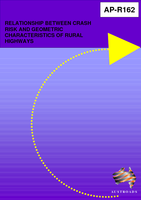Road Safety

Relationship between Crash Risk and Geometric Characteristics of Rural Highways
- Publication no: AP-R162-00
- ISBN: 0 85588 555 6
- Published: 1 January 2000
- PDF (free) Download
This paper reports a study which brings together information on road geometry (curvature and grade), cross-section, traffic flow and crashes. It allows the influence of these other factors on road crashes to be assessed in ways not possible before. The used a Geographic Information System (GIS) to relate the different information streams. Road geometry data was available from pre-existing surveys carried out using an instrumented vehicle (Gipsi-Trac), and this data was used to build an electronic map using the ARCINFO GIS. Width of traffic lanes, shoulders and shoulder seal was determined by site inspection and added to the GIS. Traffic flow data from road authority records was also added. Crashes were located on the GIS using information in the sketch maps and narratives in the police accident reports. The ARCINFO software allowed links to be established between the crash database and the ARCINFO map, creating a powerful analysis tool which allows the location of all crashes of a single type to be located, or a listing of the types of crash along a nominated stretch of road to be obtained. The analysis indicates that crash rate varies more in response to horizontal curvature than grade, that crash rate increases only for very sharp curvature but that the increase in rates can be large, that lane width (greater than 3.0m) has little impact on crash rates, and that sites with sealed shoulders have lower crash rates than sites without sealed shoulders, although there is no consistent reduction in crash rates as sealed shoulder width increases. Analysis by logistic regression generally confirmed these results.
- AP-R162/00 RELATIONSHIP BETWEEN CRASH RISK AND GEOMETRIC CHARACTERISTICS OF RURAL HIGHWAYS
- Contents
- Acknowledgements
- EXECUTIVE SUMMARY
- 1. INTRODUCTION
- 2. PREVIOUS STUDIES
- 3. PRIORITIES FOR THE PRESENT STUDY
- 4. METHOD
- 5. THE ROUTES CHOSEN FOR INVESTGATION
- 6. RESULTS — ROUTE DESCRIPTIONS
- 7. RESULTS — CRASH RATES IN RELATION TO GEOMETRIC AND CROSS-SECTION FEATURES
- 8. STATISTICAL ANALYSIS
- 9. FURTHER ANALYSIS BY CRASH TYPE
- 10. DISCUSSION
- 11. REFERENCES
Related publications
AP-R700-23
Latest Road Safety News
